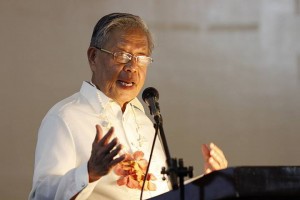Ban on commercial fishing needs ‘political will’ to enforce 3-year management plan for seascape approved
BOUNTY OF THE SEA

Former Chief Justice Hilario Davide Jr.: “Be not afraid of who is
losing business because of our environment decisions.”
A ban on commercial fishing in the biodiversity-rich Tañon Strait between Cebu and Negros islands remains its main source of protection but illegal operators still pose a major threat.
The ban needs “political will” to enforce, said former Chief Justice Hilario Davide Jr., guest speaker at a three-day summit of stakeholders held in Cebu City
“If you have the political will, be not afraid of who is losing business because of our environment decisions,” he told barangay captains, mayors, nongovernment groups and government agencies at a dinner forum.
Yesterday, a three-year management plan was approved in principle by the 380-member Protected Area Management Board (PAMB), which sat down for the first time with private and public stakeholders to flesh out steps to safeguard the bounty of the Tañon Strait in three provinces of Cebu, Negros Oriental and Negros Occidental.
Davide said this was “the crucial stage of protecting the environment” as 17 years had passed since a 1998 Presidential Decree declared the Tañon Strait a protected area, amid resistance from local governments and commercial fishers.
At an open forum yesterday, Mayor Nelson Garcia of Dumanjug, south Cebu stood up to question the legality of the 1998 decree.
PESTS

Dumanjug Mayor Nelson Garcia: “Do you think fishing (by local fishermen) can support 4 million people in Cebu?”
He said the catch of local fishermen in municipal waters was not enough to meet the demand of Cebu.
“Why do you have to restrict the Tañon Strait (from commercial fishing). Do you think fishing alone (by local fishermen) can sustain or support 4 million people in Cebu?” Garcia said.
He called whale sharks and dolphins found in the Tañon Strait “pests” that eat two tons of fish a day and “compete”with the livelihood of Dumanjug’s 500 fishermen.
With its 450-kilometer coastline, the Tañon Strait is one of the country’s major fishing grounds and the largest marine protected area covering 5,182 square kilometers.
Coral reefs, an abundant variety of fish – sardines, tuna, squid – make their home in the narrow strait which is also the habitat of 14 out of 27 species of whales and dolphins found in the Philippines.
Retired chief justice Davide, known as the “green justice” for penning landmark environment cases in the Supreme Court in Factoran vs. Oposa, said “we have the right to a balanced and healthful ecology” under the Constitution.
“But for every right that we have is a corresponding obligation. While we emphasize the duty of the government to protect the environment it is also our obligation to do so not only for ourselves but also for the future generation,” Davide said.
“The best legacy you can leave is the preservation of your environment. Think that you are not a part of a problem, think that you are a part of the solution. This is your time, this is the legacy you can leave your people. If you have the political will, be not afraid of doing that, be not afraid who losing business because of our environment decisions,” Davide said.
One of the biggest obstacles to protecting the Tañon seascape is commercial fishing and weak law enforcement.
The area is protected by law to ensure that fisherfolk use passive fishing gear and non-destructive methods to lessen damage to the fish catch, seafloor and juvenile and spawning fish.
But commercial operators with purse seines and other large vessels over three gross tons still enter and use destructive gear banned by law, including hulbot-hulbot, dynamite and modified Danish seine, according to Oceana, an international ocean care group that organized the three-day Cebu summit.
A contrary view was repeatedly expressed by Mayor Garcia, who stood up to argue in favor of commercial fishing.
“Which is more important , the need of the fish or the need of men… all these people or the so-called environmentalist talking about (managing resources for future resources) are only good in theories.
It’s never happened that there are too many commercial fishers in one town. I want to kill all the sharks. I want to regulate (shark hunting). The whales are competing with the fishermen,” Garcia said.
“I hope people will rally for me,” he said. Several mayors and barangay captains in the audience shrugged their shoulders while a number looked irritated.
In reaction, the PAMB chairman, Regional Executive Director Isabelo Montejo of the Department of Environment and Natural Resources (DENR) read to Garcia the provisions of the NIPAS law which governs protected areas.
With the vast size of the Tañon Strait, four site management units (SMUs) need to be put up in Cebu, Negros Occidental, Negros Oriental I and Negros Oriental II.
The presence of whales and dolphins and other marine mammals in the area are considered by scientists as indicators of the area’s rich marine biodiversity.
Under Republic Act 8550 or the Philippine Fisheries Code of 1998, municipal or city governments can only authorize small and medium size commercial fishing vessels to operate within municipal waters which is 10.1 to 15 kilometers from the shoreline.
Conditions are set: 1) it must have a depth of more than 7 fathoms; 2) no active fishing gear must be used; 3) proper consultation and public hearing with the municipal or city FARMC; and 4) the vessel or owner of the vessel has not violated the fisheries code and other environmental laws.
Garcia insisted that commercial fishers should be allowed in areas deeper than seven fathoms even if it falls within the municipal waters.
Garcia said fish catch in his town has been declining, and that some local fishermen have resorted to being habal-habal drivers to earn a living.
He also said the Cebu Provincial Ordinance on shark protection needs to be revisited.
“We have to change our perspective to see the entire picture. Mn should be the first to survive. The bible says that man should have dominion over the ocean, over the fishes and the animals. That is the order of God. You mean you want to starve the people just because of the whale,” Garcia said.
Environment and Social Issues
The PAMB yesterday identified various issues to tackle in environment, socio-economic and governance areas.
These include 1) habitat degradation including mangroves, sea grass and the illegal construction of infrastructure in coastal or foreshore areas; 2) poaching of marine mammals; 3) pollution from industrial waste, improper sewerage disposal, dumping of waste and unregulated use of plastic.
Protected Area Superintendent (PASu) of the Tanon Strait Protected Area Management Board, Viernov Grefalde said these are mainly caused by weak law enforcement, absence of an effective monitoring team and inefficient garbage collection among others.
Coastal communities have limited livelihood opportunities. Fish catch has declined in municipal waters intruded by commercial operators.
Population pressure is also a factor, said Lemnuel Aragones, associate professor of the Institute of Environment Science and Meteorology of University of the Philippines, Diliman.
There is a lack of baseline data on all coastal habitats, fishery stocks that is needed to craft sound guidelines and ordinances.
MANAGEMENT PLAN
A three-year management plan drafted by the DENR was approved during the summit. It aims to improve strengthen the co-management of areas and the protected area office.
There are 42 cities and municipalities that are mandated to protect the entire Tanon Strait. In 2013, DENR finished the delineation of boundaries of all LGUs for easier management but this is subject for approval of Namria.
PAMB yesterday approved the creation of four site management units, the roles and composition of the executive committee and the PAMB en banc.
Three management zones within the Tanon Strait will soon be established, the core zone, which is marine protected areas, mangrove areas, and other areas designated by PAMB as protection zone; the buffer zone where fishing will be allowed and managed; and multiple-use zone where establishment of fish corals, tourism activities, port facilities among others such as economic activities.
Aside from the Special Use Agreement in Protected Areas (SAPA) fees, additional fees shall soon be established.
Disclaimer: The comments uploaded on this site do not necessarily represent or reflect the views of management and owner of Cebudailynews. We reserve the right to exclude comments that we deem to be inconsistent with our editorial standards.
